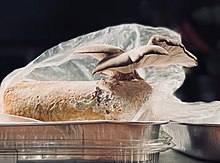
Pleurotus ostreatus, the oyster mushroom, oyster fungus, hiratake, or pearl oyster mushroom is a common edible mushroom. It is one of the more commonly sought wild mushrooms, though it can also be cultivated on straw and other media.

The Strophariaceae are a family of fungi in the order Agaricales. Under an older classification, the family covered 18 genera and 1316 species. The species of Strophariaceae have red-brown to dark brown spore prints, while the spores themselves are smooth and have an apical germ pore. These agarics are also characterized by having a cutis-type pileipellis. Ecologically, all species in this group are saprotrophs, growing on various kinds of decaying organic matter. The family was circumscribed in 1946 by mycologists Rolf Singer and Alexander H. Smith.
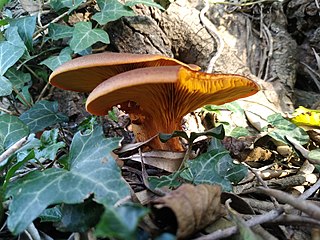
The Omphalotaceae are a family of fungi in the order Agaricales. Basidiocarps are most frequently agarics, but occasionally corticioid or poroid.

Neolentinus is a genus of wood-decaying agarics with tough fruit bodies composed of dimitic tissue, serrated lamella edges, and nonamyloid white binucleate basidiospores among other features. It was segregated from Lentinus in the broad taxonomic sense, hence the derivation of the name. Biologically Neolentinus species produce a brown rot type of decay of wood, whereas Lentinus causes a white rot. Molecular phylogenetic analysis shows that the two genera are unrelated. Neolentinus is phylogenetically allied to other brown rot genera such as Gloeophyllum, Heliocybe, and Veluticeps. A new order, the Gloeophyllales, has been described for these fungi. Heliocybe had been placed in synonymy but it differs phylogenetically and anatomically by the lack of clamp connections that all Neolentinus produce on their generative hyphae.

Pleurotus eryngii is an edible mushroom native to Mediterranean regions of Europe, the Middle East, and North Africa, but also grown in many parts of Asia.

Omphalotus is a genus of basidiomycete mushroom, in the family Omphalotaceae, formally circumscribed by Victor Fayod in 1889. Members have the traditional cap and stem structure. They are saprobic, and fruit in clumps on the ground, adjacent to host trees. The best known and type species is the jack-o'-lantern mushroom (Omphalotus olearius). Species of Omphalotus have been mistaken for chanterelles. All Omphalotus species are presumed poisonous, causing gastrointestinal symptoms. Some Omphalotus species have bioluminescent properties.

Omphalotus nidiformis, or ghost fungus, is a gilled basidiomycete mushroom most notable for its bioluminescent properties. It is known to be found primarily in southern Australia and Tasmania, but was reported from India in 2012 and 2018. The fan or funnel shaped fruit bodies are up to 30 cm (12 in) across, with cream-coloured caps overlain with shades of orange, brown, purple, or bluish-black. The white or cream gills run down the length of the stipe, which is up to 8 cm (3 in) long and tapers in thickness to the base. The fungus is both saprotrophic and parasitic, and its fruit bodies are generally found growing in overlapping clusters on a wide variety of dead or dying trees.
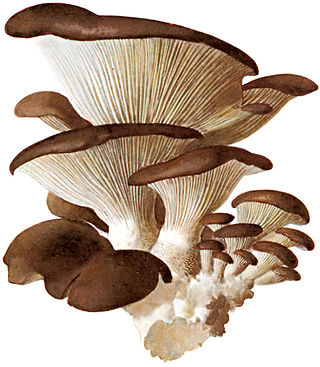
The Pleurotaceae are a family of small to medium-sized mushrooms which have white spores. The family contains 13 genera over 412 species. Members of Pleurotaceae can be mistaken for members of Marasmiaceae. Perhaps the best known member is the oyster mushroom, Pleurotus ostreatus.

Panus conchatus, commonly known as the lilac oysterling, smooth panus, or conch panus, is an inedible species of mushroom that occurs throughout the Northern Hemisphere. Its fruitbodies are characterized by a smooth, lilac- or tan-colored cap, and decurrent gills. The fungus is saprophytic and fruits on the decomposing wood of a wide variety of deciduous and coniferous trees. Despite being a gilled species, phylogenetic analysis has shown it is closely related to the pored species found in the family Polyporaceae.

Panellus is a genus of more than 50 mushroom species of fungi in the family Mycenaceae as defined molecularly. Prior to molecular analyses the generic name had been used for any white-spored pleurotoid with amyloid spores. Unrelated but similar species are now classified in Sarcomyxa and Scytinotus. In older guides and other literature the type species had been placed in either Pleurotus or Panus and the poroid species had been classified in the synonymous genus Dictyopanus or in broadly defined genera like Polyporus (Polyporaceae) or the more closely allied Favolaschia (Mycenaceae). The closest molecular allies are Resinomycena and Cruentomycena.

Pleurotus australis, the brown oyster mushroom, is a gilled fungus native to Australia and New Zealand. It is found on dead wood. Although morphologically similar to some other Pleurotus fungi, it has been shown to be a distinct species incapable of cross-breeding.

Pleurotus purpureo-olivaceus is a gilled fungus native to Australia and New Zealand. It is found on dead wood of Nothofagus trees. Although morphologically similar to some other Pleurotus fungi, it has been shown to be a distinct species incapable of cross-breeding and phylogenetically removed from other species of Pleurotus.
Pleurotus tuber-regium, the king tuber mushroom, is an edible gilled fungus native to the tropics, including Africa, Asia, and Australasia. It has been shown to be a distinct species incapable of cross-breeding and phylogenetically removed from other species of Pleurotus.

Gilled fungi with laterally-attached fruiting bodies are classified as pleurotoid. Pleurotoid fungi are typically wood-decay fungi and are found on dead and dying trees and coarse woody debris. The pleurotoid form is polyphyletic, having evolved a number of times within the Basidiomycota. Many species of pleurotoid fungi are commonly referred to as "oyster" mushrooms. Laterally-attached fungi with pores rather than gills are referred to as bracket fungi.
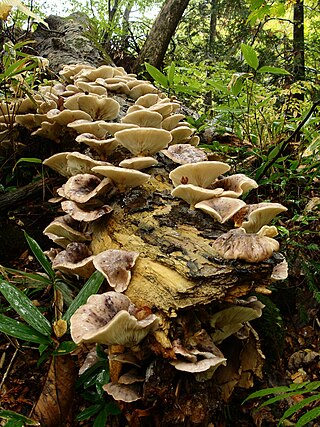
Omphalotus japonicus, commonly known as the tsukiyotake(月夜茸), is an orange to brown-colored gilled mushroom native to Japan and Eastern Asia. It is a member of the cosmopolitan genus Omphalotus, the members of which have bioluminescent fruit bodies which glow in darkness. A 2004 molecular study shows it to be most closely related to a clade composed of Omphalotus nidiformis of Australia, Omphalotus olivascens of Western North America and Omphalotus olearius of Europe.

Hypsizygus ulmarius, also known as the elm oyster mushroom, and less commonly as the elm leech, elm Pleurotus, is an edible fungus. It has often been confused with oyster mushrooms in the Pleurotus genus but can be differentiated easily as the gills are either not decurrent or not deeply decurrent. While not quite as common as true oyster mushrooms, they have a wide range globally in temperate forests. The mushrooms and vegetative hyphae of this species have been studied in recent years for their potential benefits to human health, and mycoremediation.
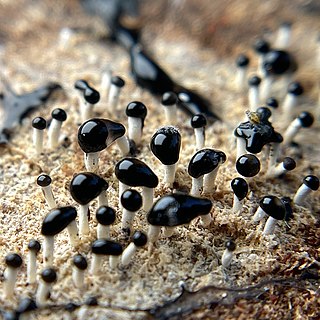
Pleurotus cystidiosus, also known as abalone mushroom and maple oyster mushroom, is an edible species of fungus in the family Pleurotaceae, described as new to science by mycologist Orson K. Miller Jr. in 1969. It can be cultivated, with spores and growing kits being available commercially. Antromycopsis macrocarpa is the anamorphic form of this species.

Pleurotus albidus is a species of edible fungus in the family Pleurotaceae. Found in Caribbean, Central America and South America, it was described as new to science by Miles Joseph Berkeley, and given its current name by David Norman Pegler in 1983. It grows on trees such as Salix humboldtiana, other willows, Populus and Araucaria angustifolia, and can be cultivated by humans. Phylogenetic research has shown that while it belongs to P. ostreatus clade, it forms its own intersterility group.

Pleurotus abieticola is an edible species of fungus in the family Pleurotaceae, described as new to science by mycologists R.H. Petersen & K.W. Hughes in 1997. It grows on rotten wood of Picea in subalpine forests dominated by it. It has been reported first in far‐eastern Russia, and then northeastern China and northwestern Russia. It can be cultivated. Phylogenetic research has shown that while it belongs to P. ostreatus clade, it forms its own intersterility group.

Pleurotus euosmus, also known as tarragon oyster mushroom, is a species of edible fungus in the genus Pleurotus, It is quite similar to the better-known Pleurotus ostreatus, but it is distinguished by its strong smell reminiscent of tarragon and substantially larger spores.






